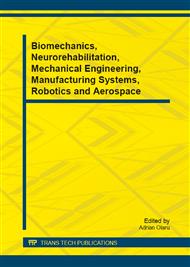[1]
M. Koucký, D. Vališ, Z. Vintr, Mission profile and its effect onto system reliability. In Proceedings of the European Safety and Reliability Conference, ESREL 2010 – Reliability, Risk and Safety: Back to the Future. London : Taylor & Francis Group, pp.1100-1106. ISBN 978-0-415-60427-7, 2010.
DOI: 10.1201/b11433-281
Google Scholar
[2]
M. Koucky, D. Valis, Reliability of Sequential System with Restricted Number of Renewals. In: Risk, Reliability and Social Safety. London: Taylor & Francis, p.1845 – 1849, 2007.
Google Scholar
[3]
Anon, One-shot reliability-growth program. In Proceedings, Annual Technical Meeting – Institute of Environment Sciences. 1992, vol. 2, p.410–414.
Google Scholar
[4]
DEF STAN 00-42 (Part1)/Issue 2. Reliability and Maintainability Assurance Guides. Part 1: One-shot Devices/Systems. Glasgow : UK Ministry of Defence – Directorate of Standardization, 2008.
Google Scholar
[5]
B. J.Hall, A. A. Mosleh, reliability growth projection model for one-shot systems, IEEE Transaction on Reliability. 2008, vol. 57, no. 1, p.174–181.
DOI: 10.1109/tr.2007.909774
Google Scholar
[6]
B. J. Hall, A. A. Mosleh, An analytical framework for reliability growth of oneshot systems, Reliability Engineering and System Safety. 2008, vol. 93, Issue 11, p.1751–1760.
DOI: 10.1016/j.ress.2007.11.003
Google Scholar
[7]
M-Y. Huang, D. McBeth, S. B. Vardeman, Development test programs for 1-shot systems: 2-state reliability and binary development-test results. IEEE Transaction on Reliability, 1996, vol. 45, no. 3, p.379–385.
DOI: 10.1109/24.536989
Google Scholar
[8]
R. Jankových, J. Majtaník, Safety risk requirements for combat pistol and its ammunition. In Reliability, Risk and Safety: Theory and Applications. (Proceedings of the European Safety and Reliability Conference, ESREL 2009). Prague, 2009, pp.1157-1161. ISBN 978-0-415-55509-8.
DOI: 10.1201/9780203859759.ch160
Google Scholar
[9]
R. Jankových, Safety requirements for Service of Pistol and its Ammunition. WSEAS Transaction on Systems, No. 12, vol. 9 (2010) 1168-1177.
Google Scholar
[10]
J. M. Moon, S. B. Vardeman, D. McBeth, Development programs for 1-shot systems: Decoupled test and redesigns, with the possibility of design degradation. IEEE Transaction on Reliability. 1999, vol. 48, no. 2, p.189–198.
DOI: 10.1109/24.784279
Google Scholar
[11]
A. S. Moses, Electroexplosive devices in aerospace vehicle systems. Supplement to IEEE Transaction on Aerospace and Electronic Systems. 1966, vol. AES-2, no. 4, p.51–56.
DOI: 10.1109/taes.1966.4501821
Google Scholar
[12]
S. Shevasuthisilp, S. B. Vanderman, Development Programs for One-Shot Systems Using Multiple-State Design Reliability Models, <http://www.interscience.com> [cit. 28-06-2004].
DOI: 10.31274/rtd-180813-8760
Google Scholar
[13]
S. Shevasuthisilp, S. B.Vardeman, Development programs for one-shot systems using multiple-state design reliability models. Naval Research Logistics. 2004, DOI: 10.1002/nav.20033, URL: http://www.interscience.willey.com>.
DOI: 10.1002/nav.20033
Google Scholar
[14]
D. Valis, M. Koucky. Contribution to availability assessment of systems with one shot items. In. Proceedings of the European Safety and Reliability Conference, ESREL 2008 – Reliability, Risk and Safety: Theory and Applications. London: Taylor & Francis Group, vol. 3, pp.1807-1812, 2008.
DOI: 10.1201/9780203859759.ch181
Google Scholar
[15]
D. Valis, Z. Vintr, M. Koucky. 2008. Contribution to modeling of complex weapon system reliability. In. Proceedings of the European Safety and Reliability Conference, ESREL 2008 – Reliability, Risk and Safety: Theory and Applications. London: Taylor & Francis Group, vol. 3, pp.1813-1818.
DOI: 10.1201/9780203859759.ch181
Google Scholar
[16]
Z. Vintr, D. Valis, Aircraft gun reliability modelling. In. Proceedings of the European Safety and Reliability Conference, ESREL 2007 – Reliability, Risk and Safety: Theory and Applications. London: Taylor & Francis Group, vol. 3, pp.2769-2774, 2007.
DOI: 10.1201/9780203859759.ch181
Google Scholar
[17]
Z. Vintr, D. Valis, Modeling and Analysis of the Reliability of System with One-Shot Items. In. Proceedings of the Annual Reliability and Maintainability Symposium 2007. vol. 53, pp.385-390, 2007.
DOI: 10.1109/rams.2007.328106
Google Scholar
[18]
C.H. Andrew, Forecasting, Structural Time Series and the Kalman Filter. Cambridge University Press, 1994.
Google Scholar
[19]
M. J.Crowder, A. C. Kimber, Statistical Analysis of Reliability Data, London: Chapman & Hall, 1991.
Google Scholar
[20]
M. S. Grewal, P. A. Angus, Kalman Filtering Theory and Practice. Upper Saddle River, NJ USA, Prentice Hall, 1993.
Google Scholar
[21]
G. Welch, G. Bishop, An Introduction to the Kalman Filter. UNC-Chapel Hill, TR 95-041, July 24, 2006.
Google Scholar


